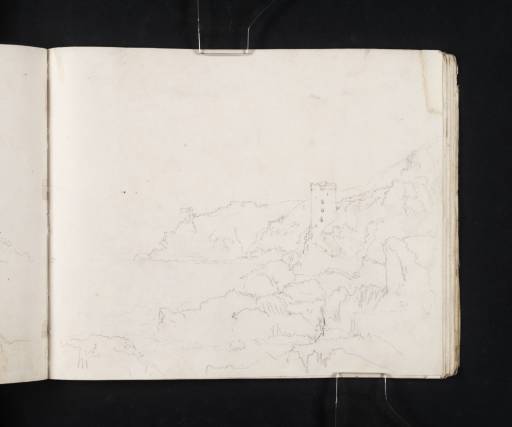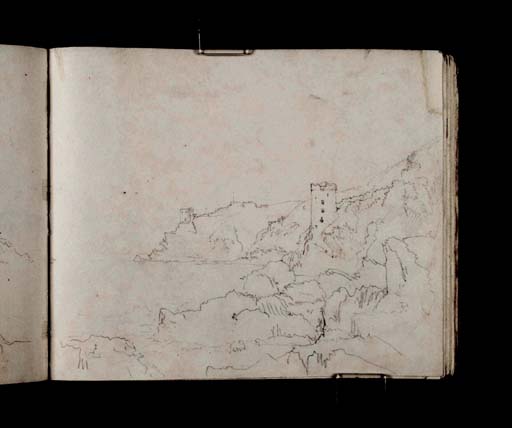Joseph Mallord William Turner Fortifications at the Entrance of Fowey Harbour 1811
Image 1 of 2
Joseph Mallord William Turner,
Fortifications at the Entrance of Fowey Harbour
1811
Joseph Mallord William Turner 1775–1851
Folio 19 Verso:
Fortifications at the Entrance of Fowey Harbour 1811
D08889
Turner Bequest CXXV 18a
Turner Bequest CXXV 18a
Pencil on white wove paper, 166 x 208 mm
Inscribed by Turner in pencil ‘Sand’ bottom centre
Blind-stamped with Turner Bequest monogram bottom right
Inscribed by Turner in pencil ‘Sand’ bottom centre
Blind-stamped with Turner Bequest monogram bottom right
Accepted by the nation as part of the Turner Bequest 1856
References
1909
A.J. Finberg, A Complete Inventory of the Drawings of the Turner Bequest, London 1909, vol.I, p.355, CXXV 18a, as ‘Entrance Fowey Harbour’.
1979
Eric Shanes, Turner’s Picturesque Views in England and Wales 1825–1838, London 1979, p.155.
1979
Andrew Wilton, J.M.W. Turner: His Life and Work, Fribourg 1979, p.353 under no.466.
1981
Eric Shanes, Turner’s Rivers, Harbours and Coasts, London 1981, p.152.
1990
Eric Shanes, Turner’s England 1810–38, London 1990, pp.178 under no.148, 266 under no.235, 285 note 127.
1991
Eric Shanes, ‘Picture Note 3: Fowey Harbour, Cornwall’, Turner Studies, vol.11, no.1, Summer 1991, p.58.
The view is towards the sea to the south along the rocky shore of the Fowey Estuary, south of Fowey itself. St Catherine’s Castle, an artillery fort dating from about the 1530s,1 is seen above St Catherine’s Point in the distance. Towards the right, the nearer tower is Foweys’s blockhouse, built around 1380 to form a pair with a similar structure on the opposite bank at Polruan, between which a chain could be raised to prevent hostile shipping entering the harbour.2 The drawing continues half-way across folio 20 recto opposite (D08890; CXXV 19), where the other blockhouse is seen to the south-west. While it and the castle survive reasonably intact, little remains of the Fowey blockhouse beyond some ragged stonework and an archway jutting from the cliff; modern houses overlook the estuary from above.
Finberg observed that the double-page sketch is the basis of the watercolour Entrance of Fowey Harbour, Cornwall of about 1817 (private collection),3 engraved in 1820 for the Picturesque Views on the Southern Coast of England4 (see the concordance of the series in the 1811 tour introduction). Eric Shanes has also noted Turner’s use of the same sketch for his watercolour of the Entrance to Fowey Harbour, Cornwall of about 1827 (Sterling and Francine Clark Art Institute, Williamstown, Massachusetts),5 engraved in 1829 for the series Picturesque Views in England and Wales.6 The viewpoints are similar, but enlivened by contrasting conditions: in the Southern Coast design the tower on the right is silhouetted against a bright if blustery sky; in the England and Wales version, the tower is brightly lit against storm clouds and shipwrecked sailors struggle to reach the shore in the foreground.
There are numerous views of Fowey in the contemporary Devonshire Coast No.1 sketchbook; see under Tate D08371 (Turner Bequest CXXIII 5a).
See [Adèle Campbell (ed.)], Heritage Unlocked: Guide to Free [English Heritage] Sites in Cornwall and the Isles of Scilly, London 2004, pp.42–5.
See ‘Polruan Blockhouse’, Fowey.co.uk, accessed 3 February 2011, http://www.fowey.co.uk/site/activities-and-attractions/polruan-blockhouse-p708123 .
Technical notes:
The top right corner has been made good where a crease along the right-hand edge had resulted in a loss.
Matthew Imms
February 2011
How to cite
Matthew Imms, ‘Fortifications at the Entrance of Fowey Harbour 1811 by Joseph Mallord William Turner’, catalogue entry, February 2011, in David Blayney Brown (ed.), J.M.W. Turner: Sketchbooks, Drawings and Watercolours, Tate Research Publication, December 2012, https://www


